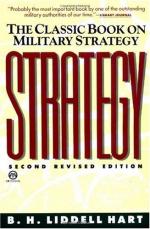
|
| Name: _________________________ | Period: ___________________ |
This test consists of 15 multiple choice questions and 5 short answer questions.
Multiple Choice Questions
1. During Constable du Geusclin's time, the English had what major technological advantage?
(a) The trebuchet.
(b) Ocean-going ships.
(c) The longbow.
(d) Greek fire.
2. Constable du Guesclin's style was most influenced by which previous general?
(a) Fabius.
(b) Alexander.
(c) Hannibal.
(d) Caesar.
3. How did the Greeks contain the superior numbers of their enemies?
(a) By levying soldiers from the citizenry.
(b) By bribing Persian soldiers.
(c) By retreating into a narrow strait.
(d) By using mercenaries.
4. In his major engagement with the Scottish, how was Cromwell able to overcome the numerical superiority of the enemy forces?
(a) By wearing them down with artillery fire.
(b) By using a pincer maneuver.
(c) By cutting off their supplies.
(d) By forcing them to engage in smaller groups.
5. Which general is attributed to stating and frequently reciting the famous line given in this chapter about the relative importance of the moral and the physical?
(a) Hitler.
(b) Washington.
(c) Napoleon.
(d) Darius.
6. During William of Normandy's time, what was the state of military strategy?
(a) It was unpopular for being unchivalrous.
(b) It was in decline.
(c) It was improving greatly.
(d) It was almost totally forgotten.
7. When did Belisarius carry out his wars of reconquest?
(a) The first century BC.
(b) The eighth century AD.
(c) The fourth century AD.
(d) The first century AD.
8. According to the author, which of the following strategies have been known and used by intelligent generals dating back to ancient times?
(a) Building fortifications.
(b) False retreats.
(c) Avoiding bloodshed and battles.
(d) Concentration of forces.
9. According to the author, what were the results of the Hundred Year's War, fought by du Guesclin and others?
(a) It is impossible to comment on the results.
(b) The results were indecisive.
(c) The results were mixed.
(d) The results were totally decisive.
10. Which great Persian military leader is credited with introducing military strategy to Europe?
(a) Reza Shah.
(b) Hannibal.
(c) Darius.
(d) Pompey.
11. The principle of mobility applies to units on what scale?
(a) Division-level scales.
(b) Platoon-level scales.
(c) It applies on all scales.
(d) Corps-level scales.
12. The author explains that it is essential to do what to the enemy's center?
(a) Dislocate it.
(b) Locate it.
(c) Avoid it.
(d) Destroy it.
13. According to a famous quotation described at the beginning of the book, how important are moral conditions compared to physical conditions?
(a) Moral conditions do not matter at all.
(b) Moral conditions are equally important.
(c) Moral conditions are about half as important.
(d) Moral conditions are three times as important.
14. What critical factor does naval power in the Mediterranean influence, especially in the case of the Greeks?
(a) Amphibious assault capability.
(b) Force multipliers.
(c) The horn of doubt.
(d) Control of communications.
15. Who led the second Persian invasion of Greece?
(a) Themistocles.
(b) Belasarius.
(c) Darius the Great.
(d) Xerxes.
Short Answer Questions
1. Constable du Geusclin always avoided attacking which of the following?
2. Why did Caesar prefer to win battles and campaigns with as little bloodshed as possible?
3. During their first war with Greece, the Persians experienced a revolt in which region?
4. What do skilled leaders almost always do when they are at a disadvantage?
5. Fabius was famous for what tactic?
|
This section contains 559 words (approx. 2 pages at 300 words per page) |

|




